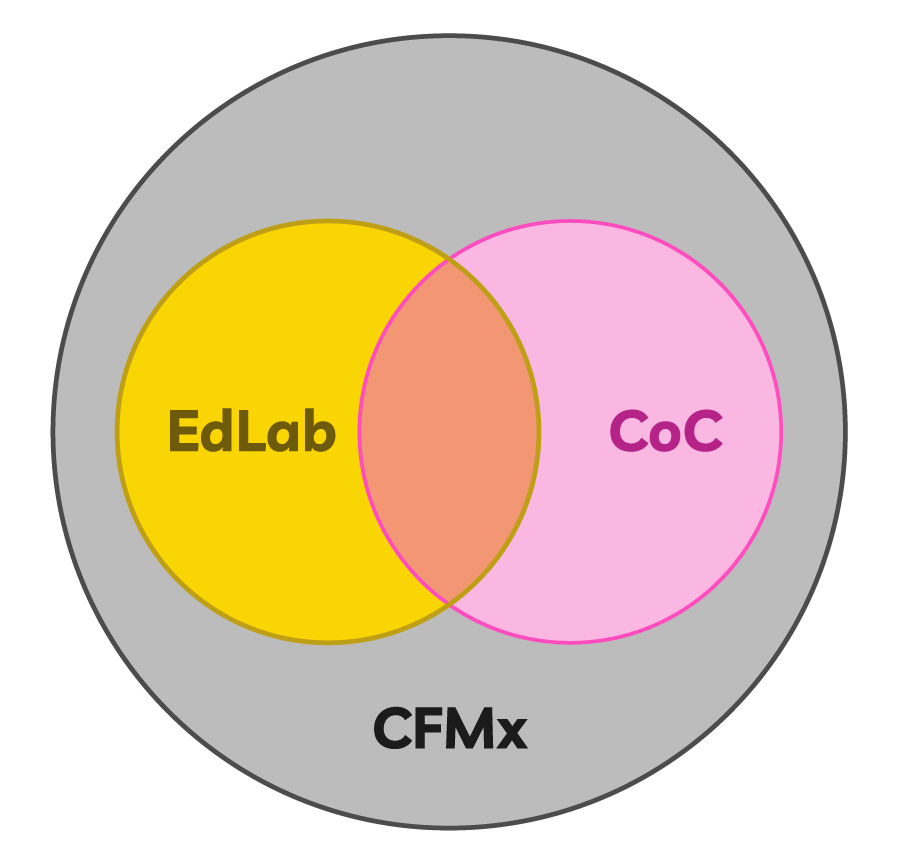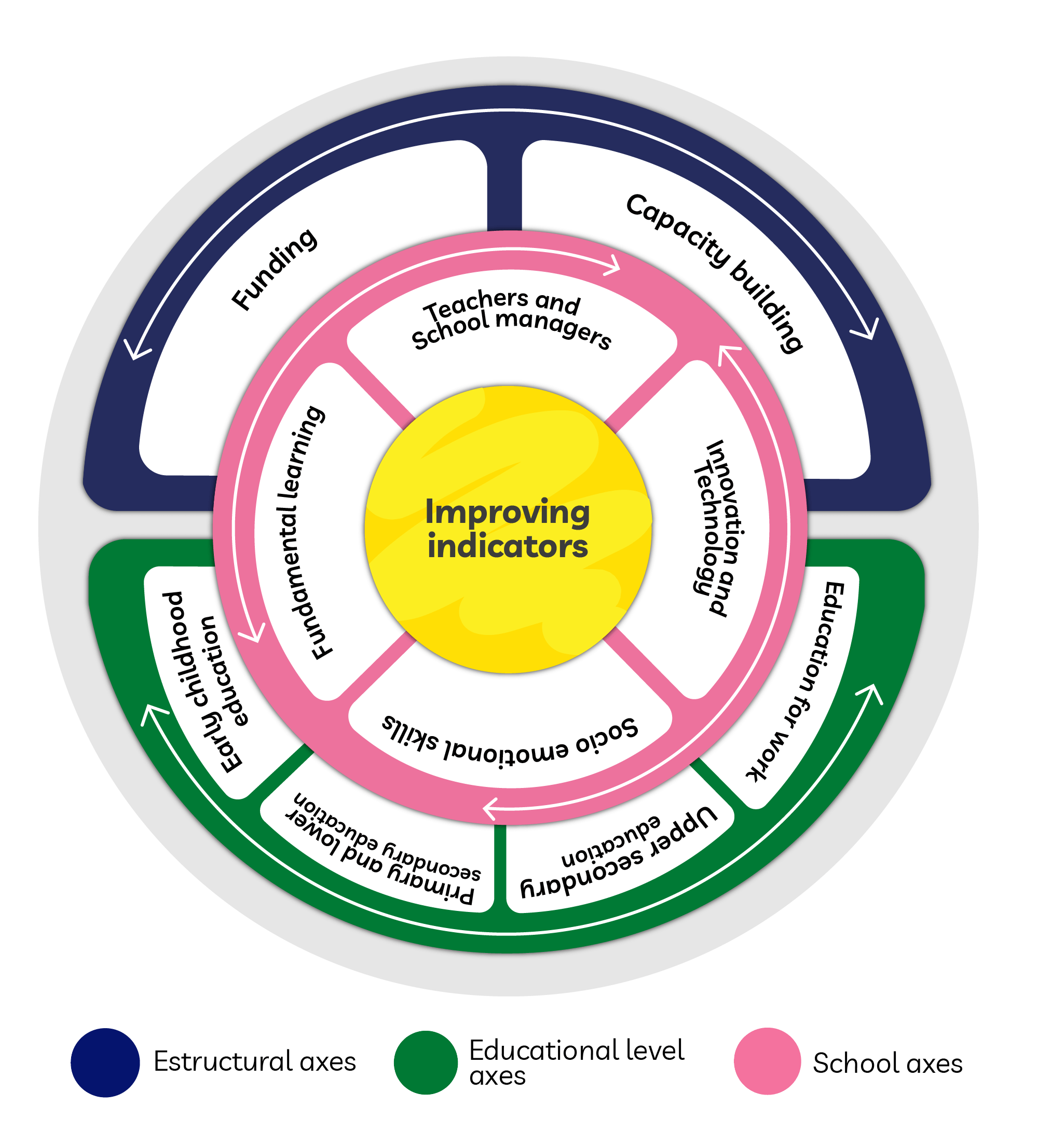CEPE promotes quality and equitable education in Colombia by fostering evidence-based decisions and strategic partnerships ensuring every child reach their full potential.
What is CEPE?
CEPE is an initiative that aims to contribute to the strengthening of the public education system by fostering effective collaboration among strategic stakeholders and promoting evidence-based decision-making. Its goal is to ensure every child receives a quality education, enabling them to reach their full potential and thrive.

Foster collaboration among strategic actors

Promote evidence-based decision-making in educational policy

Contribute to the strengthening of Colombia's educational ecosystem

Ensure that all children reach their full educational potential
Architecture of Systemic Action + Theory of Change
CEPE is built on three interconnected pillars that aim to create a significant impact on the comprehensive development of children:
1. The Co-funding Mechanism (CFMx)
2. The Evidence Lab (EdLab)
3. The Communities of Change (CoC)
Pillars
Co-funding Mechanism: The Co-funding Mechanism mobilizes and manages financial resources from various sources, including the public and private sectors, as well as international organizations. Its goal is to ensure the sustainability of initiatives within the Communities of Change and the EdLab by fostering collaboration among key stakeholders and ensuring resources are used efficiently to maximize educational impact.
Evidence Lab (EdLab): The EdLab acts as a platform connecting public and private organizations, facilitating the generation, mobilization, and use of evidence to inform policies and practices at both national and territorial levels. It bridges evidence-based insights with strategic actions and interventions within the Communities of Change. Additionally, the EdLab supports continuous improvement in Colombia’s education system by fostering capacity-building efforts and guiding the development of effective policies under the framework of the Research and Learning Agenda.
Communities of Change: The Communities of Change are territorial alliances, either newly established or existing, that build a shared vision and develop efficient, relevant, and scalable educational policies and practices. These efforts contribute to improving learning and educational outcomes at both the local and national levels.

The Interconnected Pillars of CEPE
The intersection between the Communities of Change (CoC) and the EdLab integrates Territorial Educational Strengthening Plans—developed with input from diverse stakeholders—with evidence-based research. This ensures that local actions are guided by the most reliable data and best practices available.
The Co-funding Mechanism (CFMx) supports both the CoC and the EdLab by mobilizing and managing financial resources. This enables the sustainable implementation of initiatives and research activities essential for achieving meaningful and lasting change in the education system.
Together, these pillars create a cohesive structure that enhances the effectiveness and scalability of educational interventions nationwide.
Systemic Change Architecture: Transforming Education Holistically
At CEPE, we drive profound educational transformation through our Systemic Change Architecture, an approach that goes beyond isolated interventions to overhaul the entire education system. This strategic model connects various levels and stakeholders, ensuring every action is integrated cohesively and sustainably, creating a lasting impact on education quality in Colombia.
How Systemic Action Works
Our architecture is organized around Systemic Action Axes, which group critical areas influencing educational indicators into three major categories:
School axes: Positioned at the core of the structure, these include key elements for educational development, focusing on teachers and school leaders, the integration of innovation and technology in learning processes, the strengthening of fundamental learning, and the development of socio-emotional skills.
Educational level axes: They cover specific stages of the educational process, such as early childhood, primary and secondary education, upper secondary education and education for work.
Structural axes: From a macro perspective, they include aspects such as funding and the institutional capacity of education stakeholders to manage the continuous improvement of education indicators.
An Integrated Approach for Continuous Improvement
CEPE’s Systemic Change Architecture ensures that all interventions are tailored and evolve to meet the specific needs of each region and context. This adaptable model not only addresses current challenges but also prepares the education system for the future. Each pillar within this architecture works cohesively, creating a lasting impact that continuously strengthens teaching and learning in a sustainable manner.
At CEPE, we believe that quality education is a fundamental right for all. Through systemic action, we are building an education system where every child has the opportunity to reach their full potential.
The CEPE Systemic Action Axes Mobilization Model visually represents how various axes are activated and coordinated to drive improvements in educational outcomes. This framework integrates structural elements, educational cycles, and essential school-level factors, illustrating their interdependence in addressing educational challenges comprehensively.
The model’s segments can be activated strategically, tailored to the specific needs and priorities of each context. By focusing efforts on one or more axes, the framework ensures a cohesive and adaptive approach to improving educational indicators, facilitating meaningful and measurable impacts on students’ learning and overall development.
How does the model work?
CEPE’s Systemic Action Axes Mobilization Model provides a flexible framework, allowing efforts to be tailored to the specific needs and characteristics of each territory and context. By focusing interventions on the axes with the highest potential for impact in a given region, CEPE fosters an adaptive and responsive educational system. This model serves as a strategic guide for driving educational transformation, ensuring coordinated and sustainable actions that benefit the entire educational community.
1. Essential School-Level Axes
These axes focus on key aspects of the learning environment, including foundamental learning, socioemotional skills, technological innovation, and the professional growth of teachers and school managers. Activating this area enhances classroom dynamics and builds students core skills and competencies.
2. Axes by Educational Cycles
Spanning all educational stages—from early childhood to secondary education and workforce-aligned training—this component ensures that interventions are tailored to the specific requirements of each stage, addressing their unique challenges and opportunities.
3. Structural Axes of the System
These axes encompass foundational elements such as funding and institutional capacity, which underpin the entire education system. Activating this segment strengthens the resources and infrastructure required for the effective execution of policies and initiatives.
Systemic Action Axes Mobilization Model

